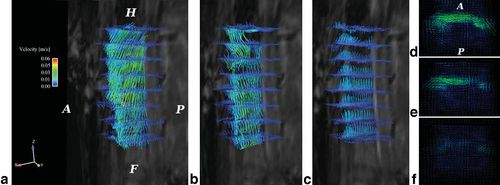Quantitative comparison of 4D MRI flow measurements and 3D computational fluid dynamics simulation of cerebrospinal fluid movement in the cervical spinal subarachnoid space
If you would like to help with this study as a master's or bachelor's thesis project, please send Bryn Martin an email with your resume and research interests.
Contents
Team
- Theresia Yiallourou
- Bryn Martin
- Leonie Asboth
- Jan Kroeger
- D. Maintz
- Nikolaos Stergiopulos
- Alexander Bunck
The problem
Computational fluid dynamic (CFD) simulations have provided detailed information about the complex flow and pressure field within the cerebrospinal fluid system (Gupta, Soellinger et al. ; Loth, Yardimci et al. 2001; Fin and Grebe 2003; Kurtcuoglu, Poulikakos et al. 2005; Kurtcuoglu, Soellinger et al. 2005; Kurtcuoglu, Soellinger et al. 2007; Gupta, Soellinger et al. 2009). The solutions of these simulations are sensitive to boundary conditions and thus need validation with in vivo measurements. However, validation of CFD flow results and MRI CSF flow measurements have been limited to thru-plane pcMR measurements. Recent advancements in MRI flow measurement technology has enabled measurement of the 7D flow field within the spinal subarachnoid space (SSS), superior sagittal sinus (Figure 1), and ventricles of the brain (Santini, Wetzel et al. 2009).
Hypothesis and research objectives
The goal of the proposed work is to measure the flow field within the SSS (C1-T1) by 7D MRI and compare the flow with a 3D CFD simulation based on the same geometry and boundary conditions.
Methods and study outline
In vivo MR measurements. Our approach is to obtain velocity and geometry measurements along the SSS in three healthy subjects, one patient with Chiari malformation, and one patient with Syringomyelia.
- 7D CSF velocity measurements in the SSS will be obtained using the protocol developed by Bunck et al. (Figure 1)(European Radiology, under review). Subjects will be asked to lie in the supine position in the scanner bed with a standard 16-channel head and neck coil (Philips). CSF flow measurements will be performed in healthy volunteers in the SSS from the C1 to T1 level with the following imaging parameters: venc = 10 cm/s, TE = minimum (5.4-6.3 ms), TR = minimum (8.6-9.5 ms), flip angle = 5°. Total scan time for each subject will be approximately 12 min.
- Thru-plane phase contrast MR measurements will be obtained at the craniospinal junction (C1) and midportion of T1 to establish the flow boundary conditions for the CFD simulation. Thru-plane velocity mapping will also be obtained at four other planes along the SSS for comparison.
- A high resolution T2-weighted 3D, turbo spin-echo sequence (image resolution: 0.8mm isotropic) will be used to define the anatomic SSS boundaries.
processing of MR data. The MR measurements will be processed using the following methodologies:
- The 7D MRI will be pre-processed and visualized using the GTFlow software (Version 1.3.10, Gyrotools Ltd., Zurich, Switzerland).
- The measured thru-plane velocity profiles at the SSS will be manually phase-unwrapped, filtered with a mask (i.e. 5x5 pixels) and smoothed using cubic spline interpolation (Gupta, Soellinger et al. 2009).
- The acquired MR geometry scan of the cervical thecal sac will be manually segmented using the freely available software Segment version 1.8 R1145 (http://segment.heiberg.se) to obtain a 3D representation of the SSS. The voxel-based segmented structures will be converted to non-uniform rational B-spline surfaces in order to allow for generation of a high-quality computational grid (Gupta, Soellinger et al. 2009).
CFD simulation. A rigid wall CFD simulation will be performed in the SSS from the C1 to T1 level using FLUENT (Fluent Inc. Lebanon, NH, USA). A computational mesh will be formed based on the MR geometry scan. CSF velocity profiles obtained at the foramen magnum will be imposed with the CSF modeled as an incompressible Newtonian fluid with the same density and viscosity as water at body temperature (Loth, Yardimci et al. 2001).
Comparison of results. The CFD results and 7D MR measurements will be compared qualitatively and quantitatively at the level of each cervical vertebra along the spinal subarachnoid space in terms of 1) peak systolic and minimum diastolic velocity, 2) stroke volume, and 3) magnitude of secondary flow.
Expected results and potential impact
We expect that the 3D CFD calculations, assuming rigid ventricle walls, will agree qualitatively with the 7D MR flow measurements in terms of the location of fluid vortices and velocity gradients within the SSS. We expect quantitative agreement to be lacking, particularly in pathological cases where movement of the neural tissue occurs. This study will help better understand the potential advantages and drawbacks of the 7D MR scan and its potential as a clinical tool for assessment of craniospinal disorders.
Preliminary results
To be posted.
References
Fin, L. and R. Grebe (2003). "Three dimensional modeling of the cerebrospinal fluid dynamics and brain interactions in the aqueduct of sylvius." Comput Methods Biomech Biomed Engin 6(3): 163-170.
Gupta, S., M. Soellinger, et al. (2009). "Three-dimensional computational modeling of subject-specific cerebrospinal fluid flow in the subarachnoid space." J Biomech Eng 131(2): 021010.
Gupta, S., M. Soellinger, et al. "Cerebrospinal fluid dynamics in the human cranial subarachnoid space: an overlooked mediator of cerebral disease. I. Computational model." J R Soc Interface.
Kurtcuoglu, V., D. Poulikakos, et al. (2005). "Computational modeling of the mechanical behavior of the cerebrospinal fluid system." J Biomech Eng 127(2): 264-269.
Kurtcuoglu, V., M. Soellinger, et al. (2005). "Reconstruction of cerebrospinal fluid flow in the third ventricle based on MRI data." Med Image Comput Comput Assist Interv 8(Pt 1): 786-793.
Kurtcuoglu, V., M. Soellinger, et al. (2007). "Computational investigation of subject-specific cerebrospinal fluid flow in the third ventricle and aqueduct of Sylvius." J Biomech 40(6): 1235-1245.
Loth, F., M. A. Yardimci, et al. (2001). "Hydrodynamic modeling of cerebrospinal fluid motion within the spinal cavity." J Biomech Eng 123(1): 71-79.
Santini, F., S. G. Wetzel, et al. (2009). "Time-resolved three-dimensional (3D) phase-contrast (PC) balanced steady-state free precession (bSSFP)." Magn Reson Med.
